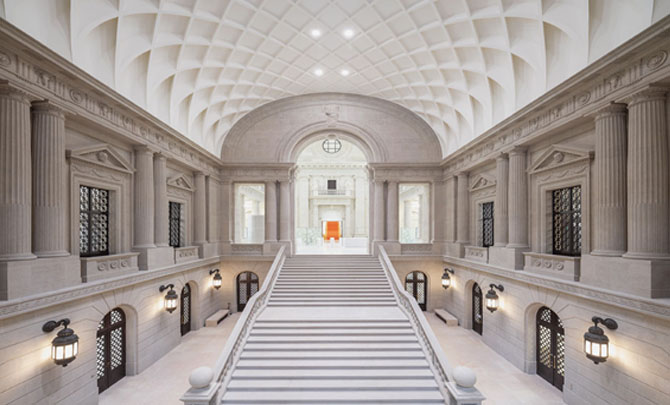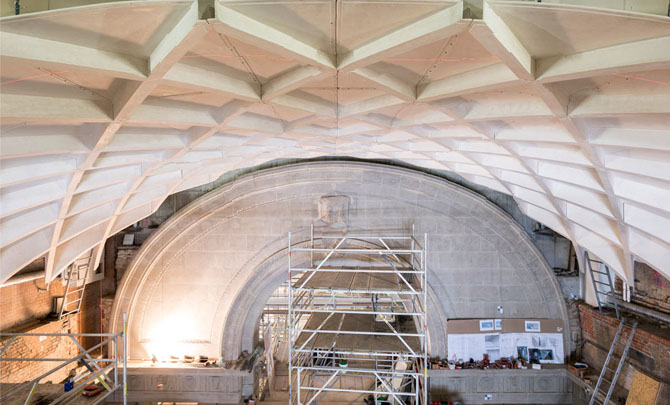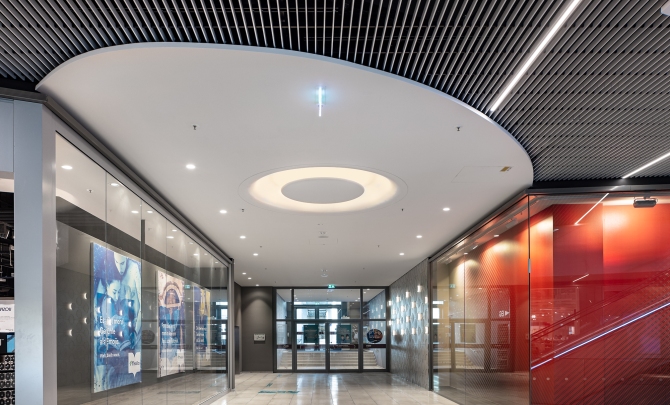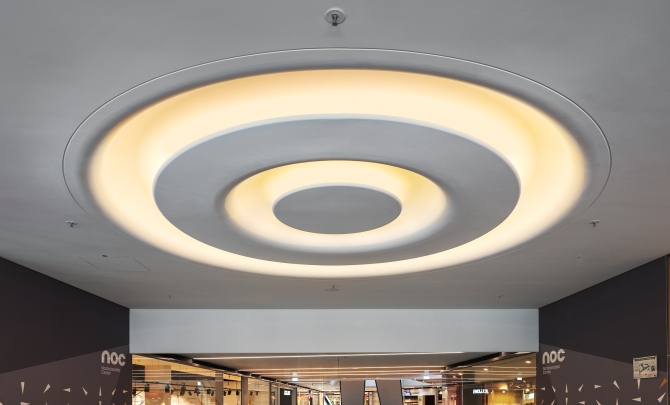
How Fibre-Reinforced Gypsum is Shaping Modern Interiors
In architectural design and construction, the demand for materials that combine aesthetics, functionality, and environmental sustainability has never been greater.
Among the myriad options available to designers and contractors, one material stands out for its remarkable properties and versatility: fibre-reinforced gypsum. This innovative material is at the forefront of acoustic performance solutions, offering unparalleled benefits in design flexibility, strength, and ease of installation.
SDG, in partnership with Vogl, a leading manufacturer of acoustic ceiling solutions, brings to the market a range of moulded components from fibre-reinforced gypsum that redefine the boundaries of architectural creativity and technical excellence. These components are not only designed to enhance the acoustic performance of buildings but also to support the creative vision of architects and the practical needs of drylining contractors.


The Story Behind Fibre-Reinforced Gypsum
Fibre-reinforced gypsum stands out for its exceptional blend of physical properties and design versatility, marking a significant advancement in material science.
A Leap in Material Science
Fibre-reinforced gypsum (FRG) is a composite material that combines the traditional benefits of gypsum plaster with the enhanced strength and durability provided by fibreglass reinforcement. This synergy results in a material that is not only lightweight but also exhibits superior mechanical strength compared to standard gypsum products. The incorporation of fibres into the gypsum matrix distributes stresses more evenly throughout the material, significantly reducing the risk of cracking and increasing its load-bearing capacity. This leap in material science opens up new possibilities for architects and contractors, allowing for the creation of intricate designs that were previously deemed too challenging or impossible to achieve with traditional materials.
The Advantage of Lightweight Design
One of the most compelling attributes of fibre-reinforced gypsum is its remarkably low weight, typically not exceeding 10kg/m². This lightweight nature facilitates the assembly of large or complex shapes without the need for extensive structural support or complicated logistics. For architects and drylining contractors, this means greater design freedom and the ability to explore more ambitious and creative solutions without being constrained by the material’s weight. The lightweight design of FRG components also contributes to ease of handling and installation on site, enabling faster project completion times and reducing overall construction costs.
Customisation at Its Core
The architectural and construction industries increasingly demand materials that not only meet technical specifications but also provide the freedom to realise unique design visions. Fibre-reinforced gypsum (FRG) offers an unparalleled level of customisation, making it a favorite among architects and drylining contractors who seek to push the boundaries of design and functionality.
Tailored Solutions for Every Design
Fibre-reinforced gypsum’s adaptability to various design requirements is one of its most valued characteristics. Whether the project calls for simple geometric shapes or more complex three-dimensional forms, FRG can be molded to fit precise specifications. This flexibility is achieved through a detailed manufacturing process where gypsum is reinforced with fibres and then cast into molds created based on the project’s unique designs. This process ensures that each component perfectly aligns with the architectural vision, offering solutions that are as practical as they are aesthetically appealing.
For architects, this means the ability to incorporate bespoke elements into their projects without compromising on structural integrity or facing significant cost overruns. Drylining contractors benefit from the predictability and ease of installation that these tailored solutions provide. By working with moulded components that are designed to fit together seamlessly, contractors can significantly reduce installation times, minimise the potential for errors, and ensure a high-quality finish.
Bringing Creative Visions to Life
The true beauty of fibre-reinforced gypsum lies in its capacity to turn creative visions into tangible realities. Architects are no longer limited by the materials at their disposal but can instead leverage the versatility of FRG to explore new forms and textures. From undulating ceilings that mimic natural landscapes to intricately detailed wall panels that bring depth and character to a space, FRG allows for the creation of unique interior environments that can enhance the aesthetic and acoustic performance of buildings.
Unmatched Technical and Functional Benefits
The technical and functional benefits of fibre-reinforced gypsum (FRG) make it a standout choice for projects prioritising durability, safety, and efficiency. This section explores the certification standards met by FRG, its non-combustibility, and the time-saving advantages offered by its use in construction projects.
Certified Quality and Safety
One of the paramount concerns in the selection of construction materials is their compliance with international standards for safety and quality. Fibre-reinforced gypsum excels in this regard, boasting certifications that attest to its suitability for use in a wide range of construction environments. The Wheel Mark certification, for instance, indicates compliance with the Marine Equipment Directive for new construction and reconstruction, ensuring that FRG components meet the highest standards of fire safety and structural integrity. These certifications are not just formalities; they represent a material’s ability to contribute to the overall safety and durability of a building.
Achieving Time Efficiency in Installation
Beyond its technical merits, fibre-reinforced gypsum offers significant practical advantages, particularly regarding installation time. The high degree of pre-fabrication associated with FRG components translates into a streamlined construction process. Each piece is designed and manufactured to fit precisely within the project’s specifications, reducing the need for onsite adjustments and speeding up the assembly process.
The ease of installation associated with FRG components minimises labor costs and the potential for human error, ensuring a smoother construction phase and a higher-quality finish.
Beyond Aesthetics: Design and Functionality
The integration of fibre-reinforced gypsum (FRG) in architectural designs transcends aesthetic appeal, embedding unparalleled functionality into each component. This material not only contributes to the visual identity of a space but also enhances its acoustic performance and environmental sustainability. This section sheds light on the creative freedom it offers, along with its adaptability in terms of colour, texture, and finishes.
Creative Freedom Unleashed
Fibre-reinforced gypsum’s ability to be moulded into virtually any shape or form is a testament to the creative freedom it offers architects. The functional benefits of FRG further enhance its appeal. Its superior acoustic properties make it an ideal choice for projects where sound quality and noise reduction are paramount. Whether it’s designing an auditorium with perfect sound distribution or a quiet, serene office space, FRG components can be tailored to meet specific acoustic requirements, improving the overall functionality of the space.
Colour, Texture, and Finish Versatility
In addition to its structural versatility, fibre-reinforced gypsum offers a wide range of finishing options that can complement any design scheme. Its surface can be coloured, textured, or coated to achieve a specific look or feel. For instance, FRG can be pigmented during the manufacturing process to match specific colour schemes, eliminating the need for painting and reducing maintenance over time. Furthermore, it can be finished with a variety of textures, from smooth and sleek to rough and rustic, providing an additional layer of design flexibility.
The material’s compatibility with different coatings and veneers opens up even more possibilities. Whether the goal is to achieve a high-gloss finish that reflects light beautifully or to use veneers for a natural wood appearance, FRG serves as an excellent substrate. This adaptability makes it a valuable tool for designers looking to explore new textures and materials in their projects.


Collaborative Support for Professionals
The successful integration of fibre-reinforced gypsum (FRG) into architectural designs and construction projects is not solely the result of the material’s qualities. Equally important is the network of support provided to architects and drylining contractors by manufacturers and suppliers like SDG and Vogl.
A key aspect of this support system is the access to expertise that SDG and Vogl offer architects and contractors. This begins with initial consultations to understand the specific needs and challenges of each project, followed by tailored advice on using FRG to achieve the desired outcomes. Technical assistance covers everything from design optimisation to ensure structural integrity and acoustic performance, to logistical support for timely and efficient material delivery.
Ongoing support during the construction phase ensures that any challenges encountered when working with FRG components are promptly addressed. This level of expert guidance is invaluable, particularly when dealing with modern materials and techniques, as it helps to mitigate risks, reduce errors, and maintain project timelines.
For architects and drylining contractors eager to push the boundaries of design and construction, embracing the possibilities offered by fibre-reinforced gypsum is a step towards achieving that goal. We invite you to connect with SDG and explore how our partnership with Vogl can bring your architectural visions to life with acoustics, efficiency, and aesthetic appeal.
Contact us today to start your journey with fibre-reinforced gypsum.
What distinguishes fibre-reinforced gypsum (FRG) from traditional gypsum products?
FRG combines the benefits of gypsum plaster with fibreglass reinforcement, resulting in a material that is not only lightweight but also exhibits superior mechanical strength. This enhanced strength reduces the risk of cracking and increases load-bearing capacity, offering greater design flexibility and durability compared to standard gypsum.
How does fibre-reinforced gypsum contribute to design flexibility in modern interiors?
FRG’s lightweight nature (typically not exceeding 10kg/m²) allows for the assembly of large or complex shapes without extensive structural support. This facilitates the creation of ambitious and creative designs, empowering architects to explore intricate forms and textures that were previously challenging with traditional materials.
Share this post